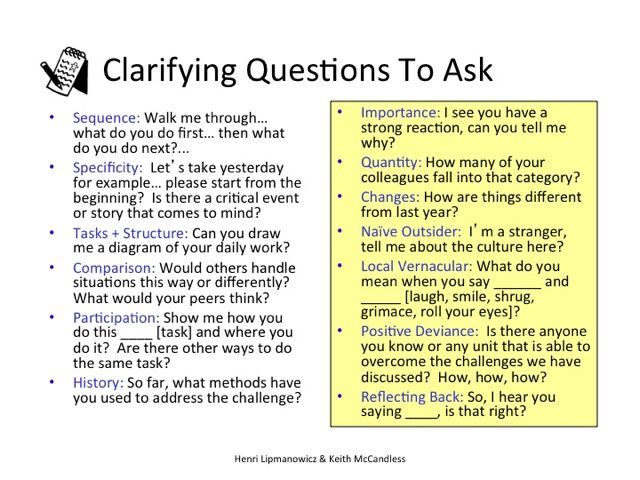![]() Simple Ethnography
Simple Ethnography
Observe and Record Actual Behaviors of Users in the Field (75 min. to 7 hrs.)
The future is already here. It is just not uniformly distributed. – William Gibson
What is made possible? You can enable participants to find novel approaches to challenges by immersing themselves in the activities of the people with local experience—often their colleagues on the front line or anyone who uses their product or service. You open the door to change and innovation by helping participants explore what people actually do and feel in creating, delivering, or using their offering. Their observations and experience can spur rapid performance improvements and expedite prototype development. The combined observations may make it easy to spot important patterns.
Structural Elements – Min Specs
1. Structuring Invitation
- Invite participants to silently observe people with experience relevant to the challenge at hand and then follow up with interviews for more insight
2. How Space Is Arranged and Materials Needed
- In a local setting (workplace, client organization, neighborhood) with a convenient space for sharing findings, photos, and videos
- Provide notebook, camera, video, permission (if needed)
3. How Participation Is Distributed
- All core-group members working on a challenge are included as ethnographers
- Everyone has an equal opportunity to contribute
4. How Groups Are Configured
- In 1s or 2s distributed among sites being observed
- Whole group for debrief
5. Sequence of Steps and Time Allocation
- Explain the problem to be solved and the current understanding of the situation. 5 min.
- Identify sites to observe and people to shadow that will reveal user experience in depth. 5 min.
- Invite participants to visit sites and observe without speaking interactions and activities, recording details and internal reflections as they go. 10–180 min.
- Ask participants to then select behaviors observed that address the challenge in a novel fashion (in part or in whole) and follow up by asking the individuals they observed what they were feeling and doing as they engaged in the behavior. 20–180 min.
- Reconvene the group of ethnographers and use 1-2-4-All to compare notes and find patterns across observations or exceptional solutions. 15 min.
- Write up observations or compose stories that highlight needs and opportunities. 10–20 min.
- Feed insights into brainstorming and prototyping efforts. 10 min.
- Repeat steps until the core-group members feel they have a particularly powerful new approach to prototype
WHY? Purposes
- Help invisible routines become visible
- Identify fundamental needs and innovative solutions
- Reveal tacit and latent knowledge not accessible by asking users for explicit needs (e.g., with focus groups)
- Show respect and trust by observing and interviewing people on the front line
Tips and Traps
- Avoid adding meaning and interpretations too quickly to the observations
- Be prepared to repeat steps if the core-group members don’t feel they have a particularly powerful new approach to prototype
- Be aware that insight comes from inconspicuous, often overlooked details
- Focus on the intrinsic qualities; ignore material or technological hierarchy
- Look for what is irregular, intimate, unpretentious
- Look for comfort with ambiguity
- Don’t ignore what is imperfect, crude, or impermanent—deviance can be positive
- Do one or more rounds of simple ethnography after you implement your new approach
Riffs and Variations
- Use a storytelling template to structure observations (e.g., the Hero’s Journey)
- Ask participants to draw or build a model of the challenge (be ready to be surprised by the deeper insights that nonverbal methods produce)
- Include clients in the observations (e.g., invite clients to record their own behaviors and share the images or video with the group)
Examples
- For sales representatives to discover how some of their colleagues are getting better results without additional resources or privileges
- For understanding how some clinicians are able to attend to the spiritual needs of patients and other are not
- For understanding why patients wander out of hospital isolation-precaution rooms despite repeated warnings
- For understanding how to reduce the patient falls in hospitals
- For understanding the differences between effective and ineffective meetings
Attribution: Liberating Structure developed by Henri Lipmanowicz and Keith McCandless. Inspired by Chris McCarthy and ethnographers in the Innovation Learning Network.
Collateral Material
Below: studying at the feet of people with local expertise via quiet observation and video capture in a Montana hospital


